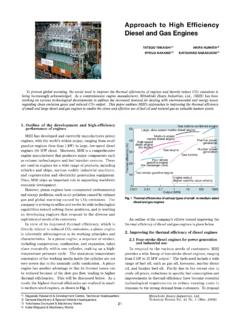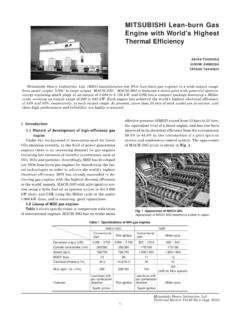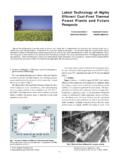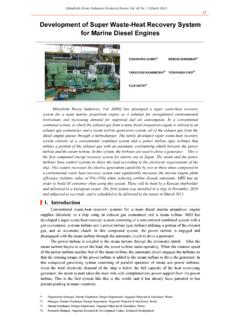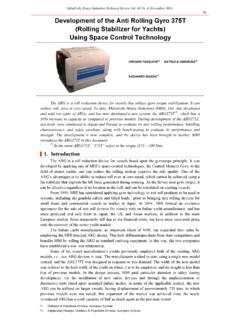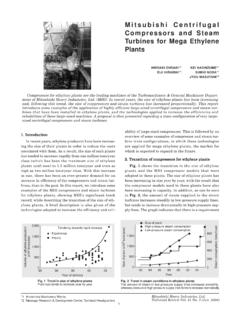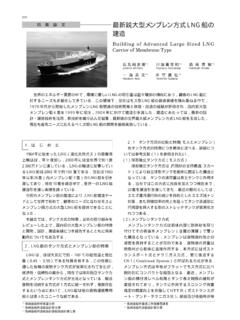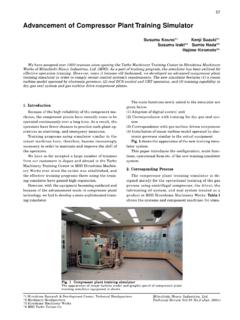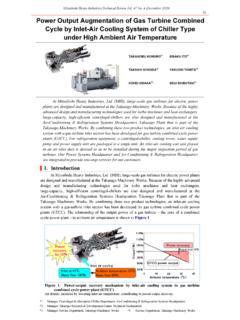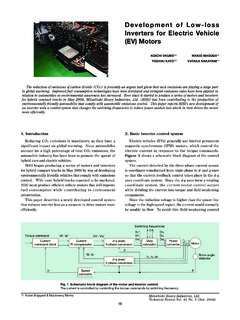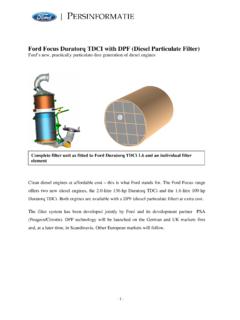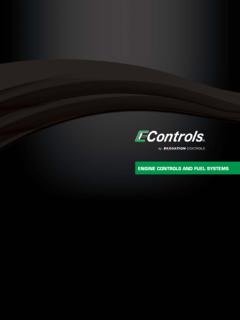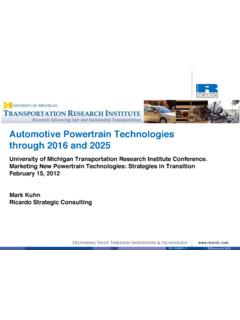Transcription of Environmentally Superior LNG-Fueled Vessels
1 Mitsubishi Heavy Industries Technical Review Vol. 50 No. 2 (June 2013) 37 *1 Senior Manager , Shipbuilding & Ocean Development, Ship & Ocean Engineering Division Environmentally Superior LNG-Fueled Vessels TAKASHI UNSEKI*1 With increasing demand for environmental protection and improvements in marine vessel operations, the International Maritime Organization (IMO) has adopted the Energy Efficiency Design Index (EEDI) for the control of emissions of nitrogen oxide (NOX) and sulfur oxide (SOX), as well as carbon dioxide (CO2) per ton mile. As one of the promising solutions for the reduction of exhaust emissions from Vessels , switching from conventional heavy fuel oils to liquefied natural gas (LNG) is being studied and pursued.
2 This article describes concept Vessels that use LNG fuels to reduce environmental impact, as developed by Mitsubishi Heavy Industries, Ltd. (MHI). |1. Introduction The IMO Tier III limits on NOX, which come into effect in 2016, are considered difficult to achieve even with an 80-percent reduction from the Tier I standard and further technological improvements in inner engine combustion. As such, the adoption of a combination of various technologies or a different approach is required. Furthermore, the EEDI requirements on CO2conflict with NOX-reduction technology. In terms of SOXregulations, the sulfur content of fuel oil within Emission Control Areas (ECAs) will be reduced to no more than percent, effective in 2015, followed by a global percent fuel sulfur limit coming into force in 2020.
3 This will require technological innovation such as a transition to low-sulfur fuels and the implementation of desulfurization equipment. As one effective solution to meeting such reduction limits, switching from conventional heavy fuel oils to LNG can potentially enable a significant reduction in NOXemissions. In addition, LNG does not contain sulfur and is thus free of SOXemissions. LNG fuels are also very promising due to the fact that CO2 emissions during combustion are becoming quite low. After reviewing the issues surrounding the use of LNG fuels in Vessels , MHI has developed LNG-Fueled ROPAX (roll on/roll off passenger) and VLCC (very large crude carrier) Vessels that significantly reduce environmental impact.
4 |2. IMO environmental regulations ECA At the 53rd session of the IMO Marine Environment Protection Committee (MEPC) in 2005, portions of the Baltic Sea and the North Sea were designated as ECAs. At MEPC 59 in 2009, areas within 200 nautical miles of and Canadian shores were also included. The ECA designation will be further extended and the phased introduction of tighter standards is being implemented. In particular, Tier III NOX limits taking effect in 2016 will target an 80-percent reduction from the Tier I standard within ECAs (Figure 1). In terms of SOXregulations, the sulfur content of fuel oil within ECAs will be reduced to no more than percent, effective 2015 (Figure 2). Mitsubishi Heavy Industries Technical Review Vol.
5 50 No. 2 (June 2013) 38 Figure 1 IMO NOX standards Figure 2 Fuel sulfur standards of IMO and CARB ECA compliance through use of fuel oil Several fuel oil-related methods are being examined by engine manufacturers to accommodate the ECA standards. SOX limits can be addressed through the use of low-sulfur fuel oils. Also being pursued and put to use is a device that cleans the exhaust gas with sea water or fresh water (injected with neutralizing agents) and thus reduces the SOX content to the regulated level (Figure 3). Meanwhile, NOX emission reduction involves a wide range of issues and approaches depending on the engine model. Technologies being examined include exhaust gas denitration equipment (Figure 4) and an exhaust gas re-circulation system (Figure 5).
6 Figure 3 Exhaust gas desulfurization equipment Figure 4 Exhaust gas denitration equipment Figure 5 Exhaust gas re-circulation system Mitsubishi Heavy Industries Technical Review Vol. 50 No. 2 (June 2013) 39 ECA compliance through use of LNG fuel Switching from fuel oils to LNG fuels, especially in a 4-cycle engine , has proven not only to achieve compliance with the most stringent regulations, but also to result in environmental performance that far exceeds such standards. In spark-ignition gas engines in particular, SOX and particulate matter (PM) in the exhaust gas can be reduced by almost 100 percent, while also reducing NOX and CO2 by more than 90 percent and 20 percent, respectively (Figure 6).
7 A major issue with current 4-cycle engines, however, is methane slip of 1-2 percent (emissions of unburned methane, which has a Global Warming Potential (GWP) 25 times that of CO2). The development of methane slip reduction technology is ongoing. Figure 6 4-Cycle engine emissions comparison between marine diesel oil (MDO) and LNG |3. Issues in LNG-Fueled Vessels LNG tank system Tanks are categorized in five shapes and types as shown in Table 1. Each has advantages and disadvantages and requires widely different ancillary facilities. As such, an appropriate tank system must be selected based on multiple requirements such as mode of operation, fuel consumption and LNG tank space. Table 1 LNG tank system Prismatic tank Spherical tankCylindrical tank Tank truck Tank type IMO type B B or C C Heat insulation External External Vacuum Vacuum Max.
8 Pressure bar 1 bar 10 Bar 10 Bar Space efficiency High Low Medium Low/Medium Gas delivery Pumping Out Pressure Built-Up Type Design cost High Medium Low Low - BOG treatment Necessary Not Necessary Suitable cap. >5,000m3 >5,000m3 30-1,000m3 30-1,000m3 <100m3 Cost High High Medium Medium Low/Medium Mitsubishi Heavy Industries Technical Review Vol. 50 No. 2 (June 2013) 40 LNG-Fueled propulsion plant LNG-Fueled engines include gas-only, dual-fuel (2-cycle low-speed and 4-cycle mid-speed), and steam turbine systems as shown in Table 2.
9 In general commercial Vessels , the use of a turbine plant is unlikely. When fitted with a gas-only engine system, the IMO International Code for the Construction and Equipment of Ships Carrying Liquefied Gases in Bulk Code (IGF Code) requires the installation of a backup LNG tank and propulsion system, neither of which is required with a dual-fuel engine system. Figure 7 shows a comparison of the environmental impact of DF low-speed and mid-speed engines and LNG-Fueled re-heat steam turbines versus a heavy oil-fueled low-speed diesel engine , which is the most fuel-efficient system currently available. The comparison indicates that the fuel-efficient DF low-speed diesel engine performs best in terms of CO2 emissions.
10 By contrast, emissions from the steam turbine are near zero, with the exception of a slightly elevated CO2 Emissions level. Table 2 LNG fueled engine Gas engine Dual Fuel dieselDual Fuel diesel 4 Cycle 4 Cycle 2 Cycle Steam Turbine Pilot fuel Spark igniter Micro pilot fuel Micro pilot fuel -- LNG Tank required 2-tanks or more 1-Tank NOX-Tier III Meet Meet Additional treatment unitMeet Stand-by propulsion Needs -- -- -- Emergency Change over to stand-by propulsion Change over to Change over to Change over to Remarks Methane slip 1~2% Methane slip 1~2% Gas burning >20% load Limited operator Figure 7 LNG-Fueled engine emissions comparison |4.
